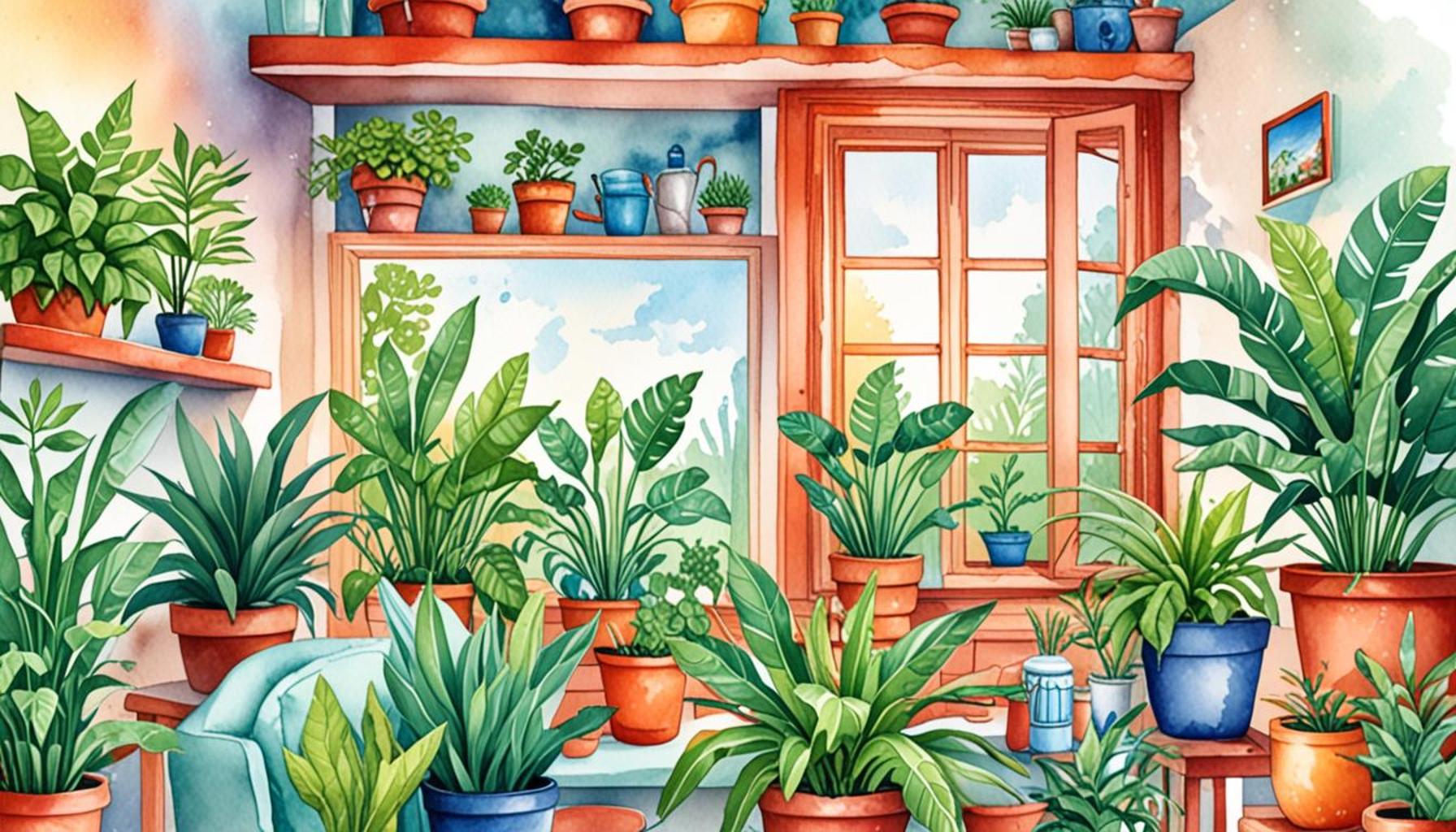Revive Drooping Plants How to Save Withered Plants from Neglect

Rescue Your Houseplants with Effective Strategies
It can be disheartening to see your beloved houseplants showing signs of distress. Plants can sometimes tell stories of neglect through their drooping leaves and lifeless stems. However, you don’t have to surrender to despair just yet. With a few simple steps, you can revive your withered plants and restore their former glory.
Understanding the Signs of Distress
Recognizing the signs of a struggling plant is crucial for successful recovery. Common indicators include:
- Drooping leaves
- Browning tips
- Wilting stems
Each symptom can provide vital clues about what your plant needs. For instance, drooping leaves often indicate a lack of water or inappropriate light conditions. If the tips of the leaves are browning, it might suggest over-fertilization or dry air. Lastly, wilting stems can signal overwatering or root rot, often caused by poor drainage. By checking for these symptoms, you can address your plant’s needs promptly and effectively.
Essential Care Techniques
Once you’ve identified a drooping plant, it’s time to consider the following strategies to rescue it:
- Adjust watering schedules: Overwatering and underwatering can both lead to plant distress. Ensure your pot has proper drainage and water only when the top inch of soil feels dry.
- Provide adequate sunlight: Many plants thrive in bright, indirect light. Consider the specific needs of your plants and adjust their location accordingly, moving them to brighter spots or utilizing sheer curtains to diffuse harsh sunlight.
- Check for pests and diseases: Inspect your plants for signs of common pests like spider mites or aphids. A simple soap and water spray can often alleviate infestations. Additionally, look for any discoloration or spots on the leaves, which can indicate fungal infections that may require treatment.

Implementing these techniques will help you breathe new life into your indoor garden. Remember, each plant has its unique requirements, so take the time to understand what works best for your specific varieties.
Time to Take Action!
Don’t let neglect define your gardening experience. With awareness and intention, you can effortlessly turn around the condition of your plants. Actively educating yourself about their needs can lead to a thriving indoor ecosystem.
Whether it’s increasing humidity for tropical plants with a pebble tray or creating a routine to check for signs of distress, each small action can yield significant results. Let’s explore how to save those drooping beauties and make them flourish once again!
Empowering yourself with knowledge and practical strategies will not only help you rejuvenate your plants but also forge a deeper connection with them as living entities in your home. Dive into the world of plant care and watch as your indoor garden transforms.
SEE ALSO: Click here to read another article
Revitalizing Your Plants: A Comprehensive Guide
To truly revive your drooping plants, it’s essential to adopt a methodical approach that considers their unique needs. Addressing the factors that contribute to their distress can significantly improve their chances of recovery. Let’s delve into specific techniques and proactive measures that can bring your withered plants back from the brink.
Assessing Environmental Factors
Before taking action, evaluate the environment where your plant resides. Several key factors can play a significant role in its revival:
- Temperature: Most houseplants prefer temperatures between 65°F to 75°F during the day and slightly cooler at night. Extreme fluctuations can cause stress, leading to drooping leaves.
- Humidity: Many plants, especially tropical varieties, thrive in higher humidity levels—typically between 50% and 70%. If your home has low humidity, consider using a humidifier or placing a tray of water with pebbles near your plants to create a microclimate.
- Soil Quality: Suitable soil is essential for healthy plant development. Ensure your potting mix is well-draining and tailored for your specific plant type. Compacted or exhausted soil can restrict root growth and nutrient absorption, exacerbating the drooping issue.
Becoming attuned to your plant’s environmental preferences is crucial. By making small modifications, you can significantly enhance their overall well-being. Regularly rotate your plants to ensure even light distribution, and move them away from drafts or direct heat sources, which can lead to inconsistent moisture levels.
Pruning and Propagation Techniques
When a plant is suffering, sometimes the best course of action is to prune it back. This doesn’t mean you have to say goodbye to your plant but rather, give it a fresh start:
- Remove Dead or Wilting Leaves: By cutting away any dead foliage, you allow the plant to redirect its energy towards new growth instead of maintaining parts that are no longer healthy.
- Propagation: If your plant is too far gone, consider propagating healthy cuttings. This can be a rewarding way to create new life while renewing your interest in plant care.
Moreover, pruning can also help improve air circulation and light penetration to the remaining healthy leaves, fostering a more conducive environment for plant recovery. When using scissors or shears, always ensure they are clean to prevent introducing pathogens to your plant.
Monitor and Adjust
As you implement these strategies, keep a close eye on your plants. Regular observation is essential to understanding how they respond to your interventions. Keep a growth journal to track their progress, and don’t hesitate to research specific care guidelines tailored to your plant species.
Remember, the journey to revive your drooping plants is often one of trial and error. With determination, patience, and knowledge, your efforts can yield vibrant results, transforming your once-neglected plants into thriving indoor companions.
| Technique | Description |
|---|---|
| Watering | Proper watering techniques are essential to reviving drooping plants. Overwatering or underwatering can lead to further damage. Use a moisture meter to find the right balance. |
| Sunlight | Assess the lighting needs of your plants. Most houseplants need indirect sunlight. Adjust the placement of your plants to help them recover and thrive. |
| Fertilizing | Use a balanced fertilizer to stimulate growth. Nutrient-deficient soil may contribute to plants’ wilting. Fertilizing helps add crucial nutrients that were lost through neglect. |
| Pruning | Prune dead or yellowing leaves to redirect energy to healthier parts of the plant. This simple technique can invigorate plants suffering from neglect. |
Understanding these techniques can provide a clear roadmap to rejuvenate your beloved plants. Cosmetic changes like rearranging pot placements alongside more technical approaches such as using moisture meters will undoubtedly revive your verdant friends. Exploring each aspect will enable plant parents to gain confidence in restoring their withered plants. Discover the intricate balance of care required to transform drooping plants back to their vibrant selves.
CHECK OUT: Click here to explore more
Understanding Nutrient Needs for Plant Recovery
In addition to environmental factors and pruning techniques, a critical aspect of reviving drooping plants lies in understanding their nutritional requirements. Plants, like all living organisms, need a balanced diet to flourish. Without the right nutrients, even the best care efforts can fall short. Here’s a deeper look into how you can nourish your plants back to health:
Fertilization Strategies
Fertilizers provide essential nutrients that plants need to grow robustly. When dealing with wilting plants, consider the following:
- Identifying Nutrient Deficiencies: Signs such as yellowing leaves or stunted growth may indicate a specific nutrient deficiency. For instance, a lack of nitrogen may cause older leaves to yellow, while a phosphorus deficiency might result in poor root development.
- Choosing the Right Fertilizer: Not all fertilizers are created equal. A balanced fertilizer typically includes equal parts of nitrogen (N), phosphorus (P), and potassium (K)—often labeled as NPK ratios. For stressed plants, a diluted liquid fertilizer can be introduced, providing immediate access to vital nutrients.
- Frequency of Application: Over-fertilization can lead to toxic buildup in the soil. Generally, fertilizing every 4-6 weeks during the growing season should suffice. However, during dormancy, reduce or suspend fertilization to avoid stressing the plant further.
By proactively addressing your plant’s nutritional needs, you can bolster their chances of revival and promote healthy growth for the seasons to come.
Watering Techniques: The Delicate Balance
Watering is perhaps the most essential yet frequently mishandled aspect of plant care. While drooping leaves often indicate under-watering, they can also signal over-watering. Mastering this equilibrium is pivotal in your recovery efforts:
- Check Soil Moisture: Before watering, always assess the soil’s moisture. A finger inserted an inch into the soil can tell you whether it’s time for a drink. If the soil feels dry, it’s time to water; if it’s still damp, hold off to prevent root rot.
- Watering Techniques: Water deeply but infrequently. Allowing the water to penetrate the soil ensures that the roots reach deep and establish a strong foundation. Consider using room temperature water, as cold water can shock the plant.
- Signs of Over and Under-Watering: Recognizing symptoms is critical—over-watering can manifest as yellow, mushy leaves, while under-watering typically leads to crispy edges and wilting. Adjusting your watering schedule in response to these signs is a key part of the recovery process.
Understanding the right watering practices will not only revitalize your drooping plants but also foster a sustainable care routine for future growth.
Repotting for Root Health
If your plant remains droopy despite your best care efforts, repotting may be necessary. This can rejuvenate a struggling plant and provide it with fresh nutrients and space to expand:
- Choosing the Right Pot: Select a pot that is slightly larger than the current one and has drainage holes to prevent water from sitting at the bottom, which can contribute to root rot.
- Transplanting Technique: Gently remove the plant from its current pot, loosening any tightly bound roots. Place it in its new pot and fill in with fresh soil, ensuring that it’s firmly but gently packed around the roots.
- Aftercare: Following repotting, hold off on fertilizing for a few weeks to allow the plant to adjust. Ensure it receives appropriate water and light as it acclimatizes.
Repotting not only provides the plant with renewed vigor but can also be a transformative experience for both you and your botanical companion.
SEE ALSO: Click here to read another article
Conclusion: Your Path to Revitalizing Plants
In conclusion, reviving drooping plants can seem like a daunting task, especially when they show signs of neglect. However, armed with the right knowledge and practices, you can navigate this challenge and breathe new life into your botanical companions. Begin by carefully assessing the environmental conditions—light, temperature, and humidity play pivotal roles in plant health. Additionally, proper pruning techniques can foster new growth and vigor, setting your plants on a path to recovery.
Understanding nutritional needs is vital. By identifying potential nutrient deficiencies and choosing the right fertilizers, you will provide your plants with the essential building blocks they require. Remember, over-fertilization can be just as detrimental as neglect, so always aim for balance.
Moreover, mastering the delicate art of watering will ensure that your plants receive adequate moisture without the risk of root rot. Regularly checking soil moisture levels is crucial to this process. If repotting is necessary, it can rejuvenate plants by offering them fresh soil and room for growth, along with reinforcing root strength.
By implementing these practices, you not only stand a good chance of rescuing your withered plants but also set the foundation for a thriving garden in the future. For those eager to delve deeper into the world of plant care, consider exploring additional resources, joining local gardening groups, or participating in online forums. The journey of reviving drooping plants can be wonderfully rewarding, transforming both your plants and your gardening skills.


